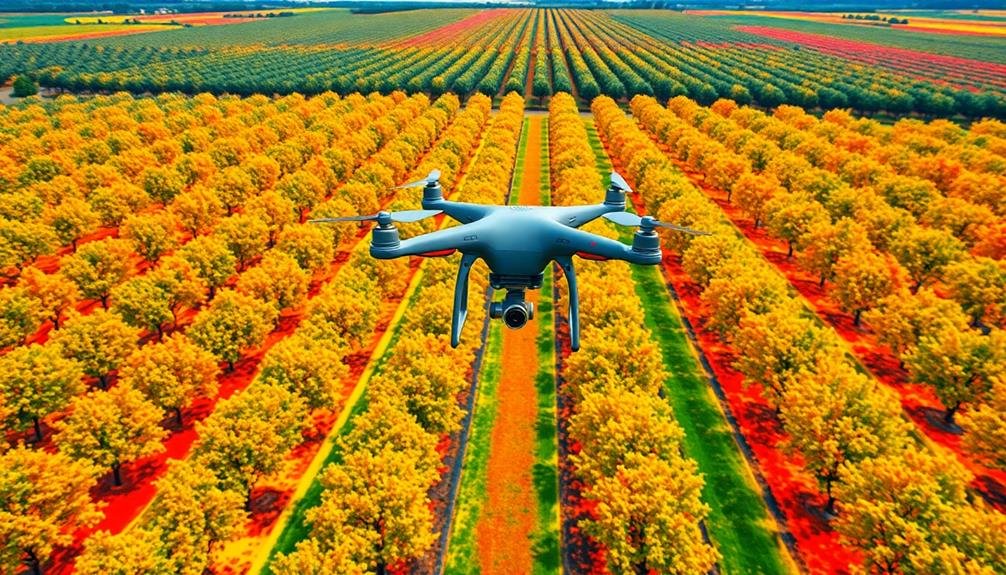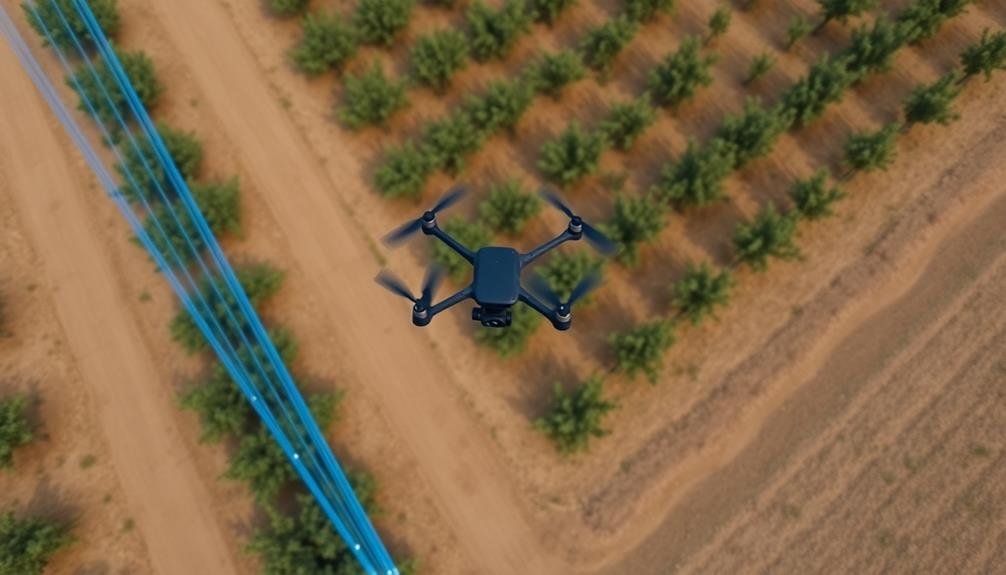Drones are revolutionizing orchard management, offering you three key benefits. First, they provide precise crop health assessments through high-resolution imaging and multispectral data, detecting early signs of disease and nutrient deficiencies. Second, drones enhance water management by identifying areas of stress or overwatering, optimizing irrigation schedules and conserving resources. Third, they enable targeted pest and disease control through early detection and precision application of treatments, minimizing environmental impact. These aerial tools create detailed maps, monitor trends over time, and reach areas difficult to access on foot. By embracing drone technology, you'll access new levels of efficiency and productivity in your orchard operations.
Precise Crop Health Assessment

Drone-powered health assessments have revolutionized orchard management. You can now gain an extensive view of your orchard's health without time-consuming ground surveys. These aerial tools capture high-resolution images and multispectral data, allowing you to detect early signs of disease, pest infestations, or nutrient deficiencies.
You'll benefit from the drones' ability to cover large areas quickly, providing detailed crop health maps. These maps highlight variations in plant vigor, helping you identify trouble spots that might be missed during traditional inspections. You can use this information to make targeted interventions, applying treatments only where needed, which saves time and resources.
Drones equipped with thermal cameras can also detect water stress, enabling you to optimize irrigation schedules. By analyzing the data collected over time, you'll spot trends and patterns in crop health, informing long-term management decisions.
This precision approach leads to healthier trees, improved fruit quality, and increased yields. You'll also reduce your environmental impact by minimizing chemical use and conserving water. Ultimately, drone-assisted health assessments empower you to make data-driven decisions, enhancing your orchard's overall productivity and sustainability.
Efficient Water Management

Building on the health assessment capabilities, drones offer groundbreaking solutions for efficient water management in orchards. You'll find that these aerial devices can quickly identify areas of water stress or overwatering, allowing you to adjust irrigation accordingly.
By equipping drones with thermal cameras, you can detect temperature variations in your trees, which often indicate water-related issues.
You can use drones to create detailed topographical maps of your orchard, helping you optimize irrigation system design and water flow. These maps reveal low-lying areas prone to waterlogging or higher ground that may require additional irrigation.
With this information, you're able to implement precision irrigation techniques, delivering water exactly where it's needed.
Drones can also monitor soil moisture levels across your orchard, enabling you to make data-driven decisions about when and where to water.
By integrating drone data with automated irrigation systems, you'll achieve more efficient water use, reducing waste and potentially lowering your water bills.
This targeted approach not only conserves water but also promotes healthier tree growth and improved fruit quality, ultimately boosting your orchard's productivity and sustainability.
Targeted Pest and Disease Control

A multitude of pests and diseases can threaten your orchard's health and productivity. Drones equipped with high-resolution cameras and multispectral sensors offer a game-changing solution for early detection and targeted treatment. You'll be able to spot signs of infestation or disease before they become visible to the naked eye, allowing for swift intervention.
These aerial devices can capture detailed images of individual trees, revealing stress patterns, discoloration, or abnormal growth. By analyzing this data, you'll pinpoint affected areas with precision, enabling you to apply pesticides or fungicides only where needed. This targeted approach not only saves time and resources but also minimizes environmental impact.
You can program drones to release beneficial insects or pheromones for pest control, ensuring even distribution across your orchard.
For larger operations, drones can carry and dispense treatments directly, reaching areas that might be challenging for ground-based equipment.
Frequently Asked Questions
How Much Does a Drone Suitable for Orchard Management Typically Cost?
You'll find that drones suitable for orchard management typically cost between $1,000 and $5,000. However, prices can vary widely based on features like camera quality, flight time, and specialized sensors. It's best to research specific models.
What Regulations Govern the Use of Drones in Agricultural Settings?
You'll need to follow FAA regulations for commercial drone use in agriculture. Register your drone, obtain a remote pilot certificate, and adhere to airspace restrictions. Don't forget to respect privacy laws and local ordinances too.
How Long Does It Take to Learn to Operate a Drone Effectively?
You'll need about 10-20 hours of practice to operate a drone effectively. It's faster if you're tech-savvy. You'll learn basic controls quickly, but mastering advanced maneuvers and camera work takes more time and dedication.
Can Drones Be Used in All Weather Conditions for Orchard Management?
You can't use drones in all weather conditions. They're limited by strong winds, heavy rain, and extreme temperatures. It's best to operate them on clear, calm days for ideal performance in orchard management tasks.
What Maintenance Is Required for Drones Used in Agricultural Applications?
You'll need to regularly clean your drone, check propellers for damage, and update its software. Don't forget to inspect batteries, calibrate sensors, and lubricate moving parts. It's essential to follow the manufacturer's maintenance schedule for ideal performance.
In Summary
You've seen how drones revolutionize orchard management through precise crop health assessment, efficient water management, and targeted pest control. By adopting this technology, you'll boost productivity and reduce resource waste. Don't hesitate to embrace these aerial tools; they're transforming the way you care for your orchards. As you integrate drones into your operations, you'll find yourself making more informed decisions and achieving better yields. It's time to take your orchard management to new heights.

As educators and advocates for responsible drone use, we’re committed to sharing our knowledge and expertise with aspiring aerial photographers.




Leave a Reply